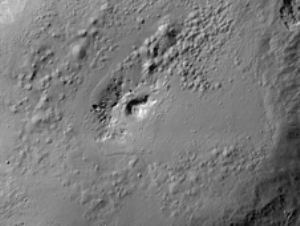Hydrated minerals have been found on the giant asteroid Vesta by NASA's Dawn spacecraft. Observations reveal that surface of Vesta has been colored by volatile materials. However, actual water ice has not been found at Vesta.
 This perspective view of Marcia crater on the giant asteroid Vesta shows the most spectacularly preserved example of "pitted terrain," an unexpected discovery in data returned by NASA's Dawn mission. Image credit: NASA/JPL-Caltech/UCLA/MPS/DLR/IDA/JHUAPL
This perspective view of Marcia crater on the giant asteroid Vesta shows the most spectacularly preserved example of "pitted terrain," an unexpected discovery in data returned by NASA's Dawn mission. Image credit: NASA/JPL-Caltech/UCLA/MPS/DLR/IDA/JHUAPL
Vesta is a part of the main asteroid belt of the solar system and is the second largest member. The volatile materials on the asteroid are expected to have been released from minerals that probably contained water. The surface of the asteroid has some pothole-like features that occurred due to the boiling of the volatiles.
Hydrated minerals, which may have come through dust and meteorites, have been found on the Vesta. The gamma ray and neutron detector (GRaND) of the Dawn at the Planetary Science Institute has detected signatures of hydrogen, which may probably be in the form of water or hydroxyl attached to minerals. The researchers surmise that carbon-rich space rocks may have collided with the asteroid at very slow speeds that enabled preservation of the volatile content in the hydrated minerals. The release of these volatiles has caused pits in the terrain.
Heat generated due to collision between space rocks and the deposits led to conversion of hydrogen, fixed to the minerals, into water. When this water evaporated, it left craters as large as 1 km wide and 200 m deep.
The data from GRaND reveal the elemental composition on the surface of the Vesta. The ratios between iron to silicon and iron to oxygen have been revealed. The observations confirm the link between the Vesta and the Howardite, Diogenite and Eucrite meteorites found on Earth.
The findings have been published in the journal Science.